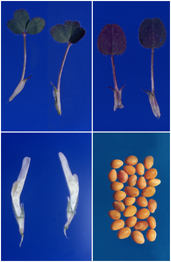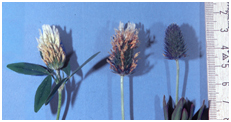

Use and productivity:
Trifolium alexandrinum provides a fodder, that is appetizing to livestock,
valuable quality and high digestibility. It has a nutritious value such as medicago sativa, but the latter
usually shows a lower content of fibers. It can be inserted into the cropping system as main growing (field
alternated of short duration) or intercalated (spring/summer herbarium ).
It has to be considered an improving
plant for its taproot and rich in tubercles apparatus. Adversities that can cause serious concern are limited;
among these, we remember: Erysiphe polygoni, it appears on the leaves, and it slowly thickens until covering
and appearing as a yellow/white efflorescence. Among other possible cryptogams we remember Phytium effusarium
that can cause damage to the plants.
- Plant growth (beginning of flowering): erect
- Height main stalk (beginning of flowering): 38.29 in.
- Shape of the terminal leaflet: elliptic
- Length of the terminal leaflet: 1.99 in.
- Width of the terminal leaflet: 0.41 in.
- Ramifications with inflorescences: n. 13
- Inflorescence: sexile
- Bract length in relationship to calyx: ½
- Vexillum colour: white/cream
- Seed colour: yellow
- Flowering classification: 145 days from the beginning of the year

- Annual plant with excellent capacity of regrowth
- Growth habit: erect
- Flowering period: medium late
- Aptitude to fodder production: excellent
- Aptitude to granular production: good
- Ratio leaf/stalk: 0.66
- Return in dry substance: 20-25%
- Cold proof: excellent





